Inclined Plane Problems
On this page I put together a collection of inclined plane problems to help you better understand the physics behind them. The required equations and background reading to solve these problems are given under the following pages: rigid body dynamics, center of mass, and friction.Problem # 1
A physicist sets up an experiment to determine the mass of a block, as shown in the figure below. In this experiment, the block is placed on top of a stationary incline, of mass M, and slowly released with a motor and pulley system, causing the block to slide down the incline a distance s. As a result, the incline slides to the left a distance d, on a well lubricated platform. If the mass of the motor and pulley system can be neglected, what is the mass m of the block?
See answer
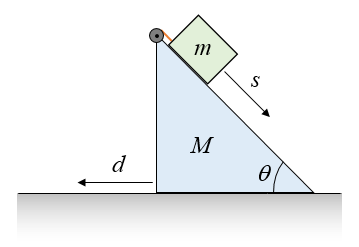
Problem # 2
A linkage of length L and mass m, which has two wheels on the ends, is placed between two inclines at an angle θ, as shown in the figure below. For α = 30°, β = 45°, L = 0.75 m, and m = 1.5 kg, what is the angle θ so that the linkage remains stationary?
See answer
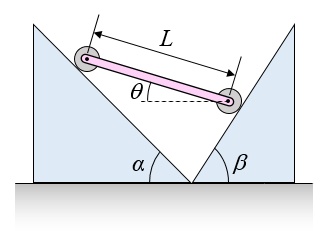
Problem # 3
A block of mass m is placed on an incline of mass M, as shown in the figure below. The coefficient of kinetic friction between the block and incline is μk. What is the minimum coefficient of static friction between the incline and floor, so that the incline doesn't slide on the floor when the block slides down the incline?
See answer
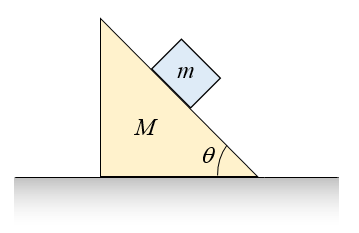
Problem # 4
Referring to the previous problem, suppose that the incline slides to the left when the block slides down the incline. If the coefficient of kinetic friction between the floor and incline is μk2, what is the acceleration of the incline?
See answer
Problem # 5
A solid cylinder of mass m and radius r is placed on an incline of mass M, as shown in the figure below. What is the minimum coefficient of static friction between the incline and floor, so that the incline doesn't slide on the floor when the cylinder rolls down the incline, without slipping?
See answer
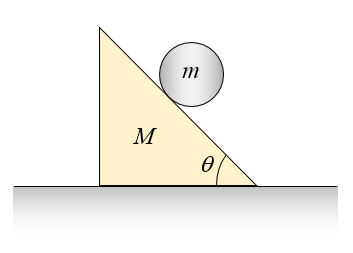
Problem # 6
Referring to the previous problem, suppose that the incline slides to the left when the cylinder rolls down the incline, without slipping. If the coefficient of kinetic friction between the floor and incline is μk, what is the acceleration of the incline?
See answer
Problem # 7
Referring to problem # 5, at what acceleration must the incline be pushed along the floor so that the cylinder does not roll on the incline?
See answer
Answers For Inclined Plane Problems
Answer for Problem # 1
Since the platform is well lubricated, we can assume that there is negligible friction between the incline and platform. This then means that there are no external forces, in the horizontal direction, acting on the system - comprised of incline, block, and motor/pulley (the mass of which can be ignored). The horizontal position of the center of mass of the system must then remain fixed. For convenience, choose an arbitrary reference point to the left of (or right of) the system. Let xM be the initial horizontal position of the center of mass of the incline, measured from this reference point, and let xm be the initial horizontal position of the center of mass of the block, measured from this reference point. The following equation then equates the position of the center of mass of the system before and after the block slides down the incline.
MxM + mxm = M(xM − d) + m(xm + scosθ − d)
Solve for m:
m = Md/(scosθ − d)
Answer for Problem # 2
The wheels can't support torque about their center of rotation, so there is no force parallel to the incline at the contact point between wheel and incline. So there is only a normal force at the contact point between wheel and incline, as shown in the free body diagram below. The normal forces are N1 and N2, and they are acting on the linkage.
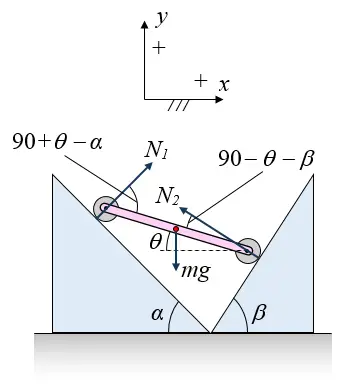
where g is the acceleration due to gravity
The torque about the center of mass (denoted by the red dot) of the linkage is
-N1(L/2)sin(90°+θ−α) + N2(L/2)sin(90°−θ−β) = 0 (1)
The sum of the forces in the x-direction is
N1sinα − N2sinβ = 0 (2)
The sum of the forces in the y-direction is
N1cosα + N2cosβ − mg = 0 (3)
Combine equations (1)-(3) to solve for θ, using the given values. We have
θ = -20.1° (the negative sign means that the linkage is instead sloped such that the right end is raised higher than the left end, at an angle of 20.1° with the horizontal)
Answer for Problem # 3
The free body diagram below shows the setup of the problem.
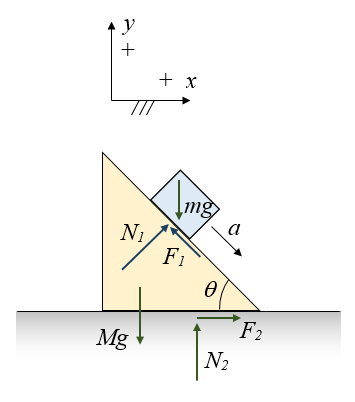
where:
N1 is the normal force acting on the block, due to contact with the incline
F1 is the friction force acting on the block, due to contact with the incline
a is the acceleration of the block down the incline
g is the acceleration due to gravity
N2 is the normal force acting on the incline, due to contact with the floor
F2 is the friction force acting on the incline, due to contact with the floor
For the block, the sum of the forces in the x-direction is
N1sinθ − F1cosθ = macosθ (1)
For the block, the sum of the forces in the y-direction is
N1cosθ + F1sinθ − mg = -masinθ (2)
From Newton's third law, the forces N1 and F1 act on the incline in the opposite direction to that shown in the figure above.
For the incline, the sum of the forces in the x-direction is
-N1sinθ + F1cosθ + F2 = 0 (3)
For the incline, the sum of the forces in the y-direction is
-N1cosθ − F1sinθ − Mg + N2 = 0 (4)
There is kinetic friction between the block and incline, so
F1 = μkN1 (5)
Combine equations (1), (2), and (5) to solve for N1 and F1. Then substitute these into equations (3) and (4) to solve for N2 and F2. Then, the minimum coefficient of static friction between incline and floor is
μs = F2/N2
and
μs = A/B
where:
A = m(sinθ−μkcosθ)
B = m(cosθ+μksinθ) + M/cosθ
Answer for Problem # 4
The free body diagram below shows the setup of the problem.
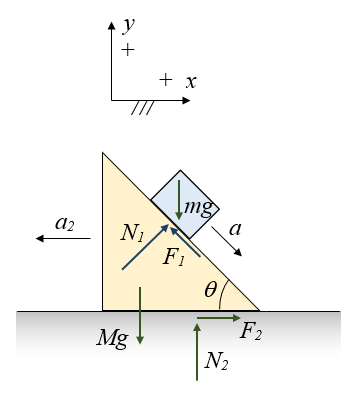
where:
N1 is the normal force acting on the block, due to contact with the incline
F1 is the friction force acting on the block, due to contact with the incline
a is the acceleration of the block down the incline, and relative to it
a2 is the acceleration of the incline along the floor
g is the acceleration due to gravity
N2 is the normal force acting on the incline, due to contact with the floor
F2 is the friction force acting on the incline, due to contact with the floor
For the block, the sum of the forces in the x-direction is
N1sinθ − F1cosθ = m(acosθ + a2) (1)
Note: On the right side of the above equation, (acosθ + a2) is the horizontal acceleration of the block with respect to ground. Acceleration must always be evaluated relative to an inertial reference frame (such as ground), when applying Newton's second law (i.e. F = ma).
For the block, the sum of the forces in the y-direction is
N1cosθ + F1sinθ − mg = -masinθ (2)
From Newton's third law, the forces N1 and F1 act on the incline in the opposite direction to that shown in the figure above.
For the incline, the sum of the forces in the x-direction is
-N1sinθ + F1cosθ + F2 = Ma2 (3)
For the incline, the sum of the forces in the y-direction is
-N1cosθ − F1sinθ − Mg + N2 = 0 (4)
There is kinetic friction between the block and incline, so
F1 = μkN1 (5)
There is kinetic friction between the floor and incline, so
F2 = μk2N2 (6)
Combine equations (1)-(6) to solve for a2. The result is
a2 = A/B
where:
A = mgcosθ(μkcosθ−sinθ) + μk2(cosθ+μksinθ)mgcosθ + Mgμk2
B = M − msinθ(μkcosθ−sinθ) − μk2(cosθ+μksinθ)msinθ
Answer for Problem # 5
The free body diagram below shows the setup of the problem.
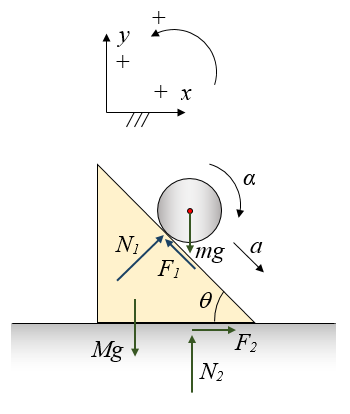
where:
N1 is the normal force acting on the cylinder, due to contact with the incline
F1 is the friction force acting on the cylinder, due to contact with the incline
a is the acceleration of the center of mass of the cylinder as it rolls down the incline
α is the angular acceleration of the cylinder as it rolls down the incline
g is the acceleration due to gravity
N2 is the normal force acting on the incline, due to contact with the floor
F2 is the friction force acting on the incline, due to contact with the floor
For the cylinder, the sum of the forces in the x-direction is
N1sinθ − F1cosθ = macosθ (1)
For the cylinder, the sum of the forces in the y-direction is
N1cosθ + F1sinθ − mg = -masinθ (2)
The torque about the center of mass (denoted by the red dot) of the cylinder is
-F1r = IG(α) (3)
where IG is the rotational inertia of the (solid) cylinder about the center of mass, and IG = (1/2)mr2
Based on the kinematics we can write,
-α = a/r (4)
From Newton's third law, the forces N1 and F1 act on the incline in the opposite direction to that shown in the figure above.
For the incline, the sum of the forces in the x-direction is
-N1sinθ + F1cosθ + F2 = 0 (5)
For the incline, the sum of the forces in the y-direction is
-N1cosθ − F1sinθ − Mg + N2 = 0 (6)
Combine equations (1)-(4) to solve for N1 and F1. Then substitute these into equations (5) and (6) to solve for N2 and F2. Then, the minimum coefficient of static friction between incline and floor is
μs = F2/N2
μs = macosθ/(Mg+mg−masinθ)
where a = (2/3)gsinθ
Answer for Problem # 6
The free body diagram below shows the setup of the problem.
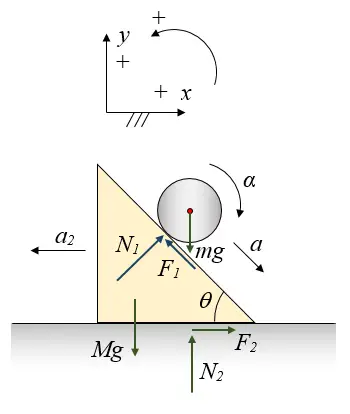
where:
N1 is the normal force acting on the cylinder, due to contact with the incline
F1 is the friction force acting on the cylinder, due to contact with the incline
a is the acceleration of the center of mass of the cylinder, as it rolls down the incline. This acceleration is relative to the incline
a2 is the acceleration of the incline along the floor
α is the angular acceleration of the cylinder as it rolls down the incline (with respect to ground)
g is the acceleration due to gravity
N2 is the normal force acting on the incline, due to contact with the floor
F2 is the friction force acting on the incline, due to contact with the floor
For the cylinder, the sum of the forces in the x-direction is
N1sinθ − F1cosθ = m(acosθ + a2) (1)
For the cylinder, the sum of the forces in the y-direction is
N1cosθ + F1sinθ − mg = -masinθ (2)
The torque about the center of mass (denoted by the red dot) of the cylinder is
-F1r = IG(α) (3)
where IG is the rotational inertia of the (solid) cylinder about the center of mass, and IG = (1/2)mr2
Based on the kinematics we can write,
-α = a/r (4)
From Newton's third law, the forces N1 and F1 act on the incline in the opposite direction to that shown in the figure above.
For the incline, the sum of the forces in the x-direction is
-N1sinθ + F1cosθ + F2 = Ma2 (5)
For the incline, the sum of the forces in the y-direction is
-N1cosθ − F1sinθ − Mg + N2 = 0 (6)
There is kinetic friction between the floor and incline, so
F2 = μkN2 (7)
Combine equations (1)-(7) to solve for a2. The result is
a2 = A/B
where:
A = (2/3)gsinθ(mcosθ+μkmsinθ) − μk(M+m)g
B = (2/3)cosθ(mcosθ+μkmsinθ) − m − M
Answer for Problem # 7
For convenience, refer to the free body diagram in the previous answer. If the cylinder doesn't roll on the incline this means that a = 0, and α = 0 - from the torque equation, this means that F1 = 0.
For the cylinder, the sum of the forces in the x-direction is
N1sinθ = ma2 (1)
For the cylinder, the sum of the forces in the y-direction is
N1cosθ − mg = 0 (2)
From equations (1) and (2) we can solve for a2, which is the acceleration of the incline. This is equal to the acceleration of the cylinder, since the incline and cylinder move together as a single unit.
So,
a2 = gtanθ (this is the required acceleration of the incline, to the right)
Return to Physics Questions page
Return to Real World Physics Problems home page
Free Newsletter
Subscribe to my free newsletter below. In it I explore physics ideas that seem like science fiction but could become reality in the distant future. I develop these ideas with the help of AI. I will send it out a few times a month.